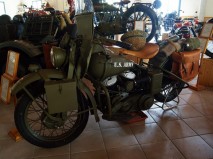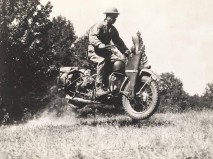1942 Harley-Davidson WLA Military
The WLA is very similar to civilian models, specifically the WL. Among the changes making it a military model:
- paint and other finishes: painted surfaces were generally painted olive drab or black and chrome- or nickel-plated parts were generally blued or parkerized or painted white. Some parts were left as unfinished aluminum. However, Harley Davidson was apparently very practical in its use of existing parts and processes, and many finishes remained in their bright civilian versions for a time, and, in some cases, for the whole production run.
- blackout lights: in order to reduce nighttime visibility, WLAs were fitted with a second set of blackout head and tail lights.
- fenders: to reduce mud clogging, the sides of the standard fenders were removed.
- accessories: a heavy-duty luggage rack (for radios), ammo box, leather Thompson submachine gun scabbard, skid plate, leg protectors, and windshield could be fitted. Most came with at least these accessories less the windshield or leg protectors.
- air cleaner: an oil bath air cleaner, originally used for tractors and other vehicles in dusty environments, was fitted to handle the dust of off-road use and to allow easier field maintenance. Oil bath cleaners require only the addition of standard motor oil rather than replaceable filters.
- fording: changes to the crankcase breather reduced the possibility of water intake into the crankcase.












